After winning Ligue 1 with Lille last season, pipping PSG to the title by just one point, Christophe Galtier embarked on a new challenge for 2021/22 when he took charge of a Nice side that finished the previous campaign in ninth place after a turbulent campaign in which current boss of EPL side Crystal Palace Patrick Vieira was sacked as manager before being replaced by Adrian Ursea until the end of the campaign.
Under the reigning French top-flight-winning manager Galtier, Nice currently sit in third place in Ligue 1, a UEFA Champions League qualification spot, level on points and goal difference with Marseille in second — an impressive jump from where they ended last season.
Following his achievements throughout his managerial career, particularly those which have come within the last 12 months, Galtier’s reputation and status within the game has grown considerably. French football journalist Florent Gautreau recently described the Nice boss and his coaching achievements as “remarkable”, while one of Les Aiglons’ summer signings, Mario Lemina who joined from Southampton in the EPL, was full of praise for his 55-year-old coach recently, with the two-time Serie A-winning midfielder declaring that Galtier has fostered a “winning culture” at Allianz Riviera.
Galtier’s achievements throughout his managerial career, from his lengthy tenure at Saint-Étienne to his title-winning stint at Lille to his current promising spell as Nice boss have made him one of the most highly-rated managers in France, with the Nice boss even getting linked with being Didier Deschamps’ successor at the French national team in recent weeks.
Plenty was written about Galtier’s tenure as Lille manager and his tactics during that time here at Total Football Analysis, but this tactical analysis piece focuses on the 55-year-old’s thus far impressive first season in charge at Allianz Riviera. I’ve picked out four key areas I’d like to focus on with Galtier’s Nice that I hope will give you a better idea of Galtier’s general ideas and vision for the team, style of play, and philosophy within the context of this Nice side and the individual qualities each player brings to the table.
The goalkeeper’s important role in the build-up
To kick off this analysis, I’ll be taking a look at the role that the goalkeeper, usually Walter Benítez, has to play in Galtier’s side. Nice aren’t an extremely possession-based side under Galtier, retaining an average of 50.5% possession in the league this season which ranks them above average but not by much. However, they do generally like to build their attacks fairly patiently at the beginning of the build-up phase. Benítez has an important role to play in this, as he needs to be calm and cool under pressure with the ball at his feet while also possessing enough technical ability to adequately find teammates with his passes, ideally while breaking lines and sending his team forward in the process, or at least playing the pass that puts a teammate in a good position to play that line-breaking pass with the next move.
This is an area in which Benítez has done quite well and been very comfortable in Galtier’s system in 2021/22. The 29-year-old ‘keeper needs to be comfortable when involved in deep phases of possession and actively drawing pressure from the opposition to create more space behind those players for higher-positioned teammates to take advantage of.
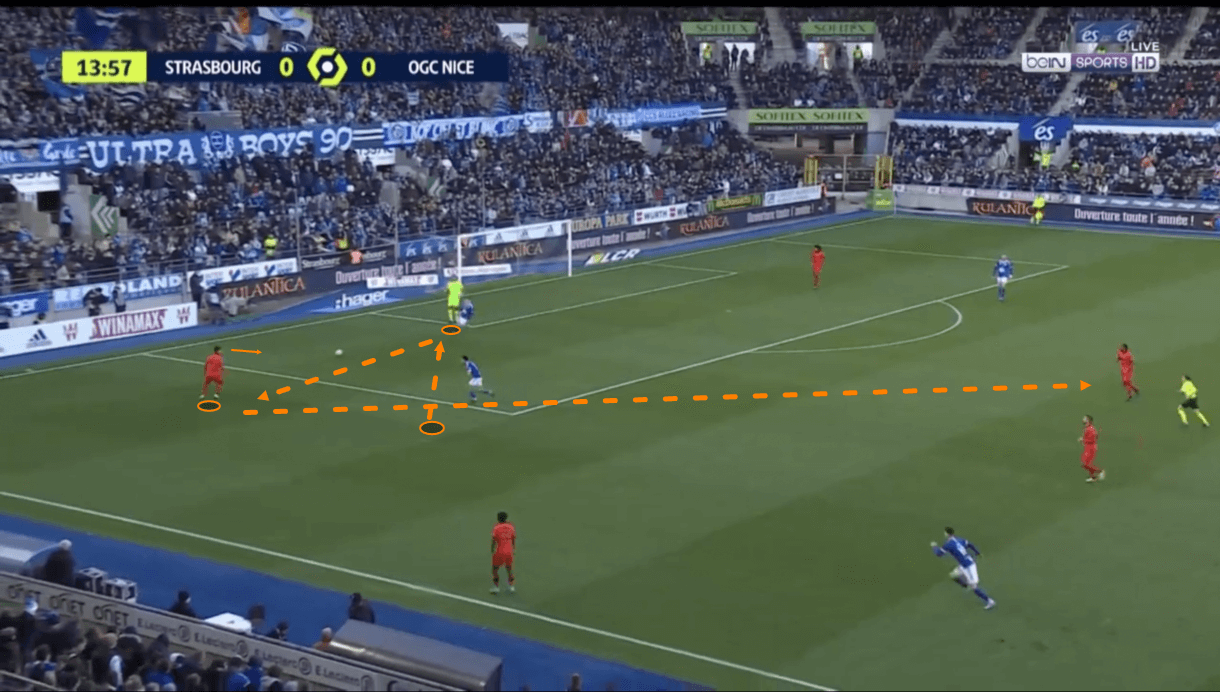
Figure 1 shows an example of an occasion when Benítez was used centrally in the build-up phase for the purpose of attracting opposition bodies further upfield to create space to exploit behind them. Firstly, just before this image, Nice’s right centre-back here, Danilo Barbosa, played the ball back to Benítez from a slightly higher position than we see him currently occupying after he came under some pressure from an opposition player who also blocked his forward passing lanes. Benítez is very good at taking up helpful positions in such situations to offer his teammates an outlet should forward passes be impossible, while he’s also very good at receiving passes under pressure, controlling the ball well, getting it out of his feet and setting up his next move. In this case, that next move was a pass back to Danilo, who has now dropped to a slightly deeper position, at right centre-back.
This is where we pick things up in figure 1 and we can see from this image that this little exchange between Danilo and Benítez created a lot of space behind the opposition’s two pressing forwards for Nice’s midfielders to potentially exploit. The midfielders get this opportunity a few seconds later as Danilo finds a way to squeeze the ball past the nearest pressing forward and send the ball into midfield, finding the feet of holding midfielder, Pablo Rosario. If Benítez weren’t so positionally aware to make good passing angles for his teammate and not technical enough to receive so well under pressure and find his teammate well with the subsequent pass, then this exchange could’ve gone a lot differently so it’s clear how the ‘keeper’s mental and technical abilities are crucial in Galtier’s plans to draw opposition players upfield to exploit space as it opens up behind them.
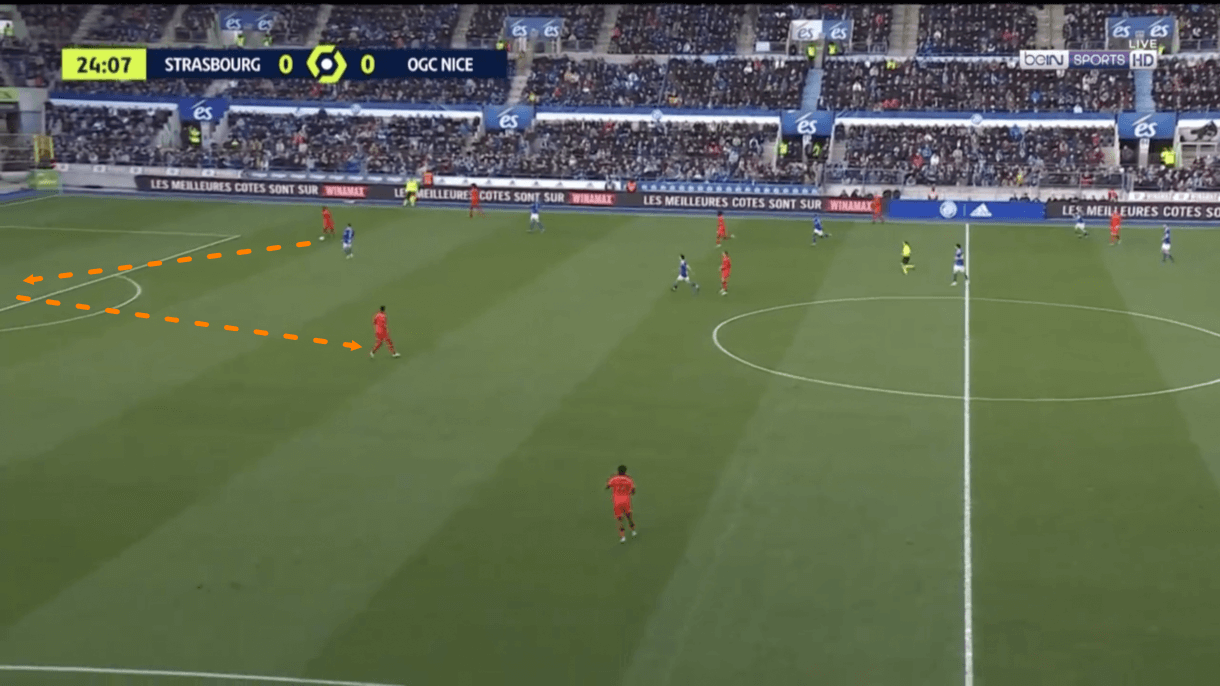
Benítez’s teammates have a lot of trust in him and are comfortable with using him when necessary, which the goalkeeper facilitates via his positioning and aforementioned technical qualities. Figure 2 shows an example of an occasion where the left centre-back’s passing lane to the right centre-back is cut off by an opposition player, which could create a problem in some situations. However, the centre-back on the ball doesn’t panic, knowing that the option of using Benítez is there, and this is the option he ultimately takes. As play moves on from this image, the centre-back plays the ball back to the ‘keeper before the Benítez quickly plays it forward to the right centre-back, which puts his team in a better position to get forward and makes the opposition forward’s initial press slightly less impactful, as Nice were still able to get from A to B, even if they had to go through C first, admittedly giving the opposition more time to re-organise and prepare for the move. Still, this again shows Benítez’s important role in possession for Nice, highlighting the necessity for the ‘keeper to possess such good technical ability.
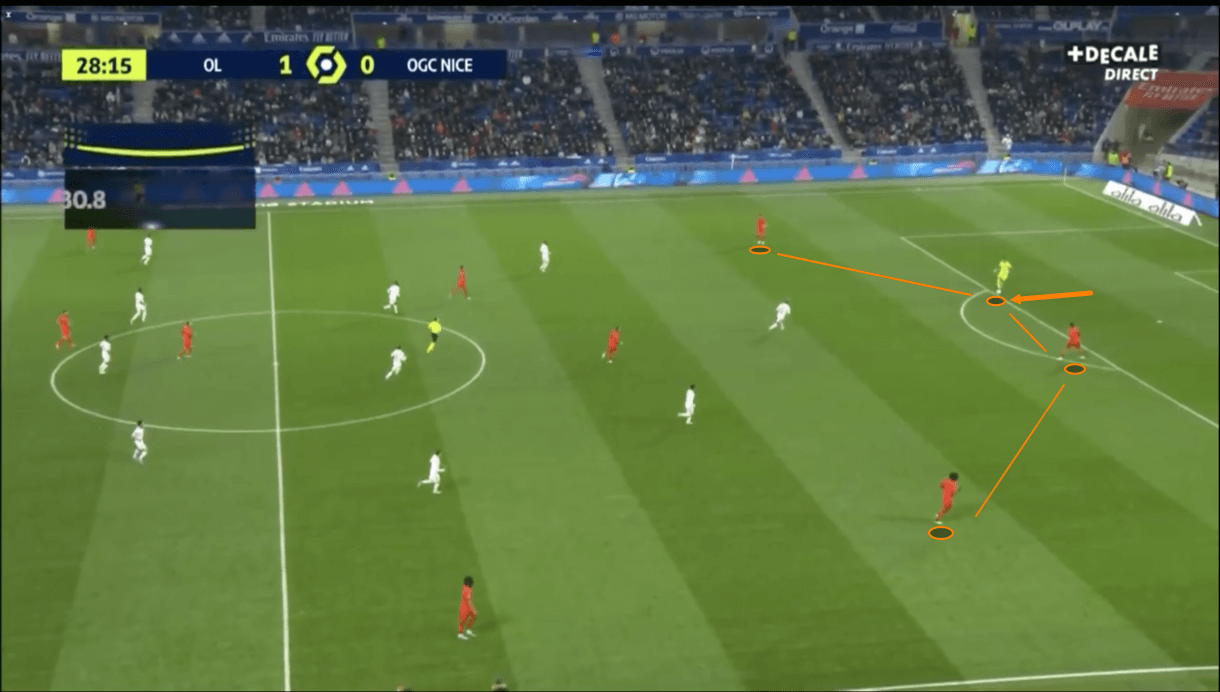
Benítez is happy to push up into the backline as his team settles into a period of possession inside their own half, as figure 3 shows. It’s common to see him take up the typical position o a centre-back, adding one more body to Nice’s first line of attack and perhaps even giving one of Nice’s full-backs licence to remain higher, potentially creating an overload in the forward line. With Galtier almost exclusively lining his team up in a 4-4-2 shape, adding Benítez to the backline can help the centre-backs to get wider, potentially creating better passing angles into the two-man midfield via the 3-2 structure this would create. If Benítez remains deeper, Nice are also happy to drop a full-back in centrally to achieve this 3-2 structure in build-up at times, again for the purpose of creating easier possibilities to get into midfield via the natural passing angles that this structure creates.
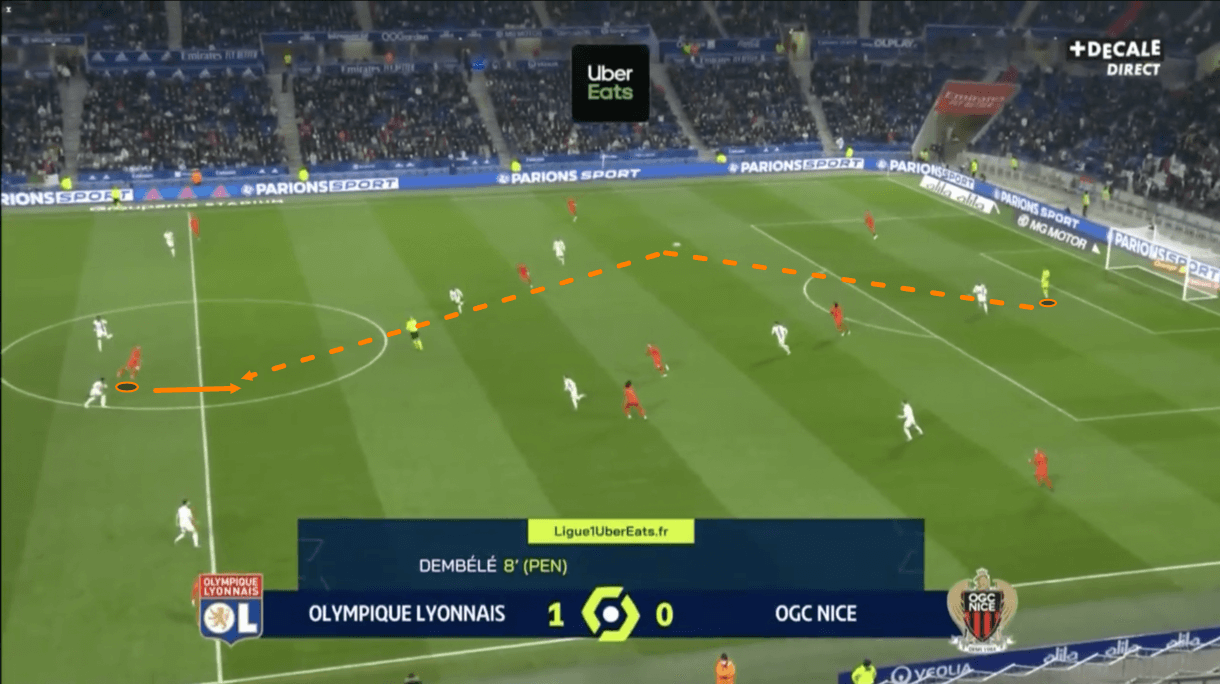
Lastly for this section, Andy Delort up front provides a good centre-forward presence and a good long passing outlet for Benítez to aim for when playing out from the back, should the opposition’s press get a little bit too intense or should all the near passing options get fully blocked off. This doesn’t mean that Nice’s intention of drawing pressure to create space was ineffective, however. Rather, it just means they need to go a little longer to exploit the space. As figure 4 shows, the opposition’s midfield remained compact with the forwards as they were drawn high by Nice’s typical deep build-up play. While this prevented space from opening up behind the forwards, it allowed space to open up behind the midfielders and here in this example, we can see Delort moving deeper to meet Benítez’s long ball as it drops into this danger zone. This shows an example of Benítez’s passing range and decision-making to know when to attempt the short passes even under pressure and when the pressure is a little bit too intense for that. All in all, this section highlights some of the important skills and traits possessed by Benítez that help him to function as the ‘keeper in this team, even though this role requires him to be heavily involved in build-up, which can be a major test for many goalkeepers.
Other points on build-up and ball progression
Two other key players for Galtier in the build-up and ball progression phases, respectively, are Dante and Pablo Rosario. This section of analysis aims to highlight the important role that these two men play in their side’s tactics in the early possession phases. Firstly, I’ll focus on why Dante is a key figure in this side but for a more in-depth scout report looking at the veteran centre-back, I’d recommend checking out this tactical analysis piece that I wrote in 2020 on his role in the early possession phases for Nice.
Dante has played the third-most progressive passes of any Nice player this term (69 per Statsbomb via FBRef) at the time of writing, trailing only left-back Melvin Bard and Rosario. The veteran Brazilian’s elite technical ability — especially as a passer — and comfortability under pressure make him an excellent asset in breaking into the middle third of the pitch in the build-up phase and breaking into the final third in the progression phase. The left-sided centre-back is great at picking passes out, reacting to movement from teammates ahead of him and adding significant threat to his side.
Dante has also played the most switches (passes that travel more than 40 yards of the width of the pitch) of any Nice player this term (40), and this is something else that’s quite significant about his role in Galtier’s system. Galtier is happy for the 38-year-old to take his time on the ball to assess his options and to play longer, riskier passes, knowing that the ex-Bayern man has the technical quality to, for argument’s sake, isolate a winger on the opposite side of the pitch to him 1v1 versus the opposition full-back, creating a very good opportunity for his side where no other player on the team would.
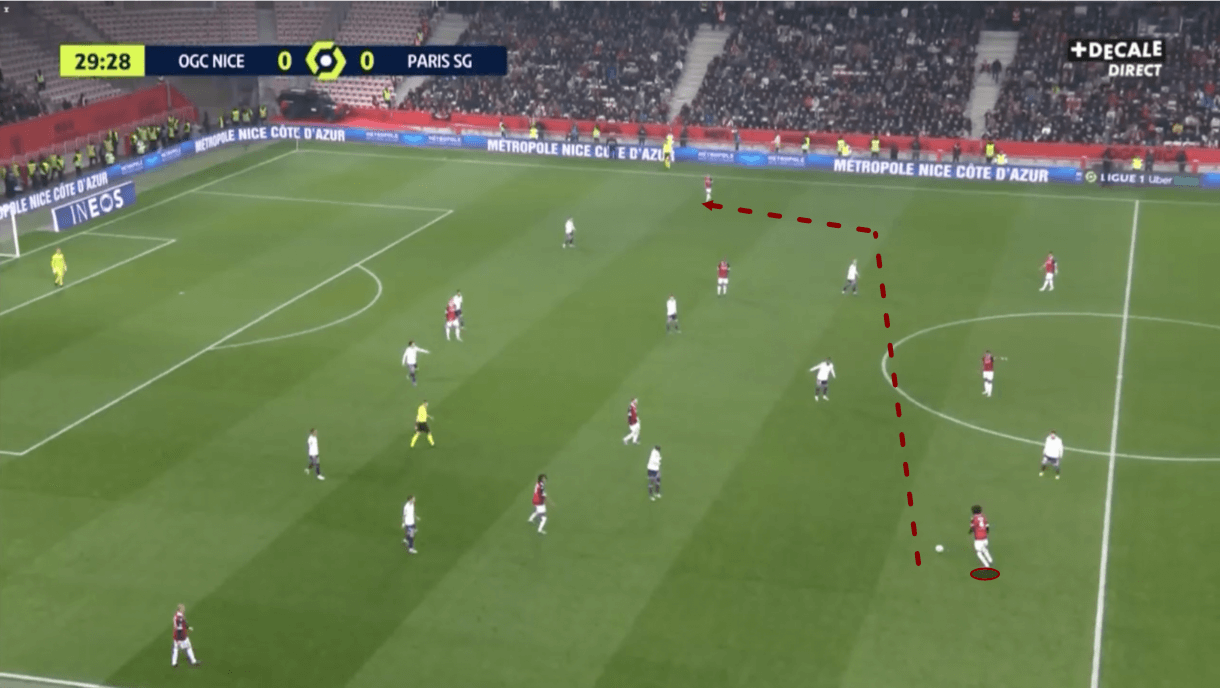
We see an example of one such occasion in figure 5. Here, just before this image, Dante picked up the ball just inside the opposition’s half. The centre-back slowed play down, got his head up, assessed the options ahead of him and opted to float a switch pass to the opposite wing, as indicated on the image above. The pass was very well weighted and directed; it ended up falling right into the winger’s feet, evading the opposition left-back and setting up a very good opportunity for the winger to run at the PSG left-back in an isolated 1v1 situation. This is just one example that shows exactly why Dante is given so much trust and creative freedom from the left centre-back position in Galtier’s system. The centre-back’s technical quality is unquestionable and as long as he continues pulling off passes like this that put his team in a heavily advantageous position, he’ll continue to have the trust of his manager and teammates to perform this ambitious role — it’s certainly paying off this term.
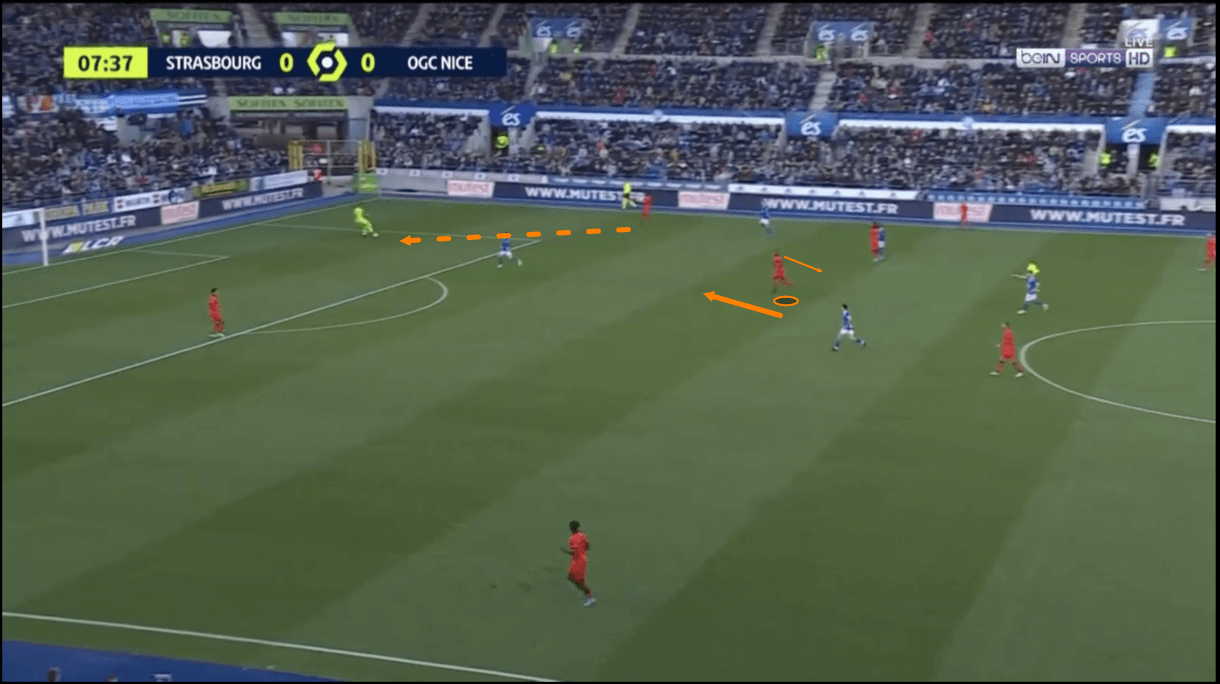
As for Rosario, again, similar to Dante, the holding midfielder is good at progressing his team through the thirds but where I think he really shines is in playing while under pressure, which figures 6-8 will highlight via analysis of this passage of play versus Strasbourg. The Dutchman has played a grand total of 197 passes under pressure this season which ranks him in joint-21st place in that particular metric among all Ligue 1 players. Again, with Rosario largely playing in deeper positions and Galtier placing plenty of importance in his strategy and tactics on drawing pressure from the opposition in deeper areas to create space further upfield, it’s imperative that Rosario is good at playing under pressure and so his skill in this area helps to make him a very good fit for Les Aiglons.
Starting with figure 6 above, here we can see Benítez receiving the ball from the left centre-back while Rosario is in the process of dropping to make himself available for the ‘keeper while checking his shoulder just before the ‘keeper welcomes the ball to confirm whether he’s got space to turn on the ball after receiving it or not. It’s an intelligent time to check the shoulder in between touches and in between passes, though with Benítez just about to receive here and Rosario unlikely to get his eyes back on the ball exactly as the ‘keeper takes his first touch, maybe the scan could’ve been made a tiny bit earlier.
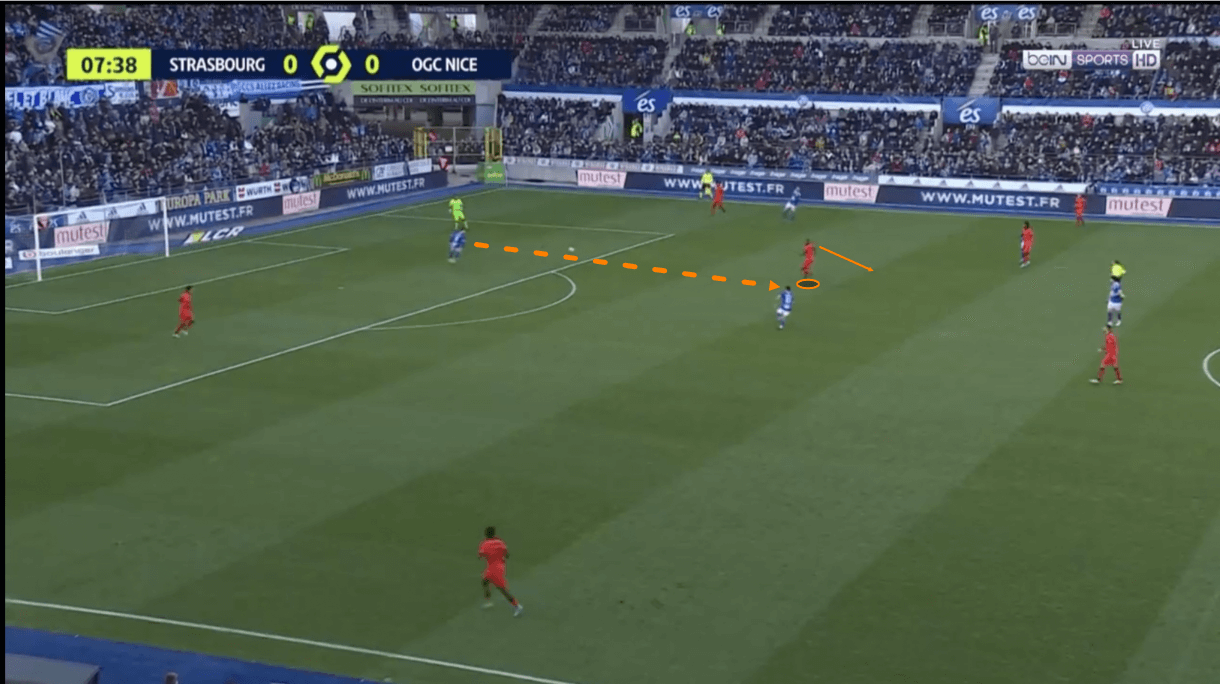
As we progress into figure 7, we see that Rosario continued to drop deeper and remained in enough space to receive, leading to the pass getting played into his feet from Benítez. As the pass is played, Rosario again wisely takes the opportunity to scan, this time choosing a very intelligent moment to do so, with the ball in-flight, just before receiving it. Through this scan, he’ll notice that intense pressure is coming from the opposition player over his left shoulder, so the midfielder intelligently decides to take a negative but controlled touch before sending the ball back to Benítez.
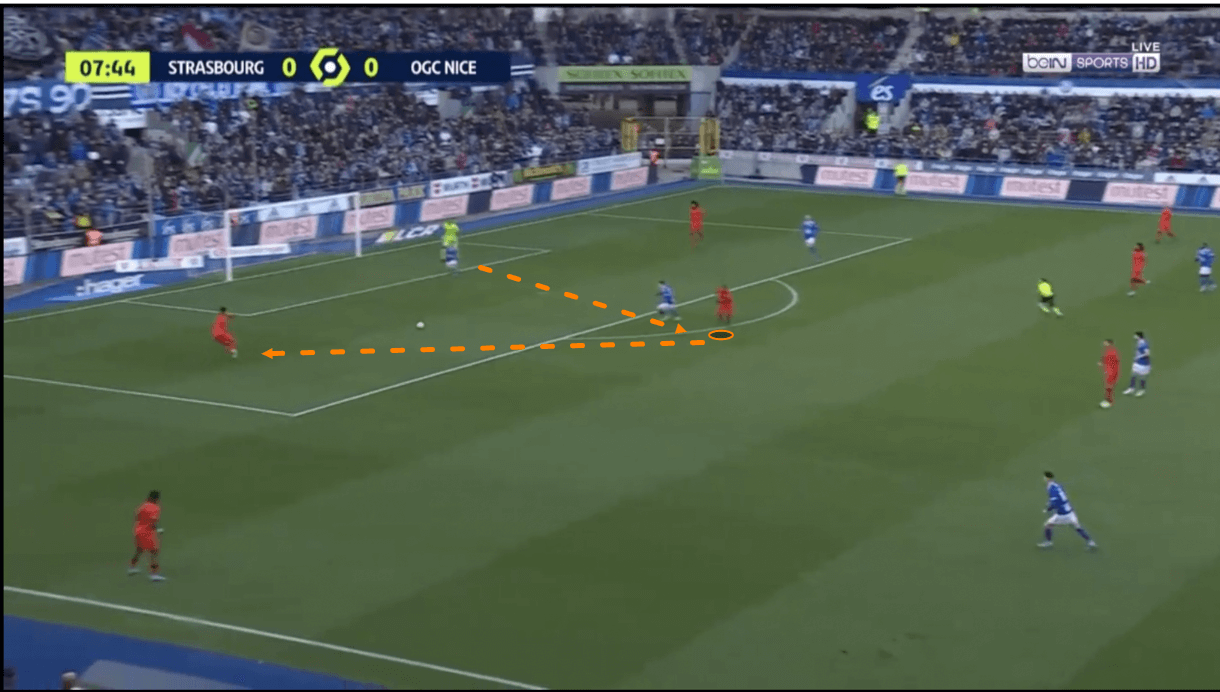
After that, as we move on into figure 8, we see that Rosario continued moving off the ball and ended up occupying a position far further to the left than he’d been occupying previously. This movement was made with the intent of getting out of his marker’s cover shadow, with the player who had been pressing him previously then staying to cut off the passing lane between the goalkeeper and himself.
The defender was unable to prevent the Dutchman from getting back on the ball, however, as Rosario demonstrated some really intelligent and effective movement to escape from the midfielder’s cover shadow just enough so that Benítez could thread another pass through into his feet, allowing Rosario to then relay the ball off out to the right centre-back who’s in plenty of space thanks to Rosario attracting all the pressure and attention to himself. This creates an opportunity for the right centre-back to drive forward with the ball and finally get Nice progressing upfield.
So, this particular passage of play doesn’t highlight Rosario’s ball progressing quality, of which he possesses plenty, rather it highlights his retention and ability to play out of pressure, which encapsulates some on-the-ball quality, such as passing and receiving the ball, as well as some off-the-ball quality, such as intelligent movement to make himself available and scanning to help his decision-making process. These mental traits, in particular, are promising for Rosario as a holding midfielder in this system that relies on attracting pressure in deeper areas to create more space upfield. It may not be a role that sees Rosario directly increase his side’s level of threat a lot, but paired with centre-backs who are also good ball progressors — which Dante and Jean-Clair Todibo are — it should see him set them up to play plenty of progressive passes and increase the amount of threat that Rosario adds to his side, which is another important role, and certainly so in Galtier’s system.
Chance creation
Next up, I’ll highlight what I’ve identified as some key tactical points regarding Nice inside the final third, in the chance creation phase. Under Galtier, Nice tend to create their chances via passes more than any other means. Their key creator, if you were to identify one player, in particular, to bestow this label upon, would be Amine Gouiri, who primarily plays as a second striker alongside Andy Delort in Galtier’s 4-4-2 system. Gouiri is Nice’s chief creator from rather central areas of the pitch. He sometimes creates from zone 14 but mainly occupies the left half-space — a valuable position from where he can cut inside onto his stronger right foot.
We have a couple of scout reports on Total Football Analysis specifically focusing on Amine Gouiri in great detail so, again, I won’t go into so much detail on the player here but I will discuss his role within this system and the significance of it.
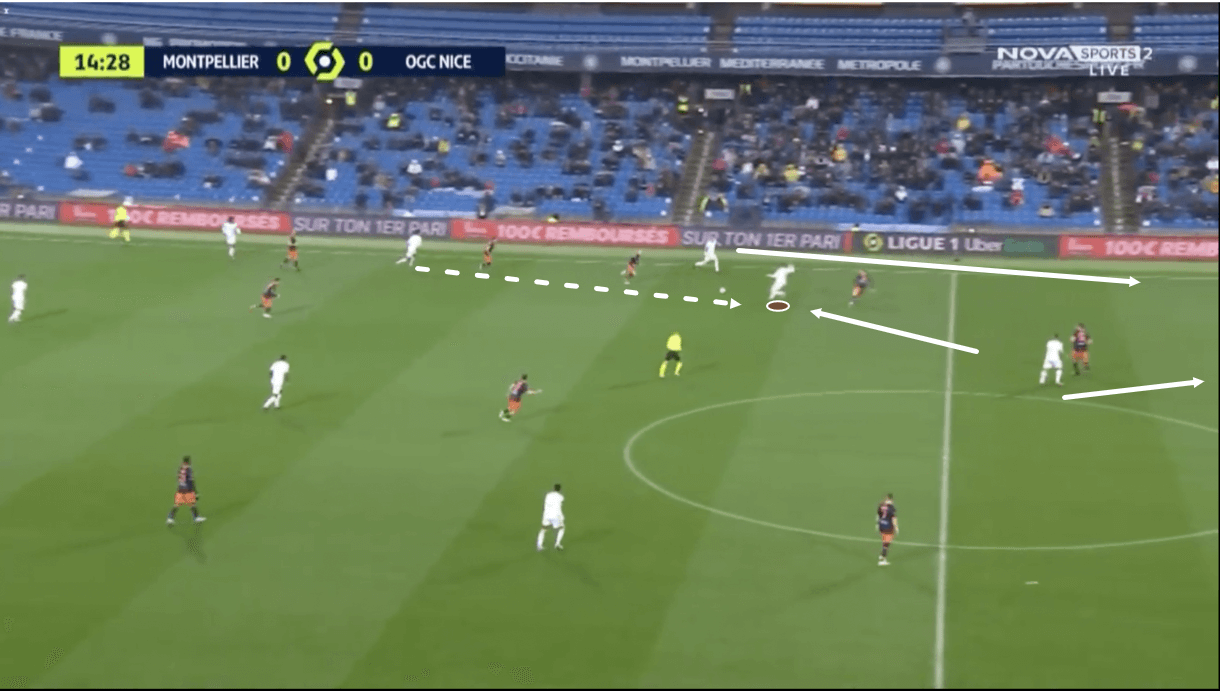
Firstly, as previously stated, Gouiri loves to operate in the left half-space, which is where we see him dropping to receive the ball from a midfielder in figure 9. From here, it’s possible Gouiri can receive and turn before running to attack the opposition goal and/or attract defenders towards himself, thus creating spaces for teammates to attack before playing them in. However, it’s also important that Gouiri has runners ahead of him in such situations so he has the option of playing a quick, defence-splitting through ball. Gouiri’s dribbling ability has been a significant part of his game throughout his career and it remains so but for me, his vision and passing quality have really stood out this season, helping him to operate successfully as Nice’s chief creator.
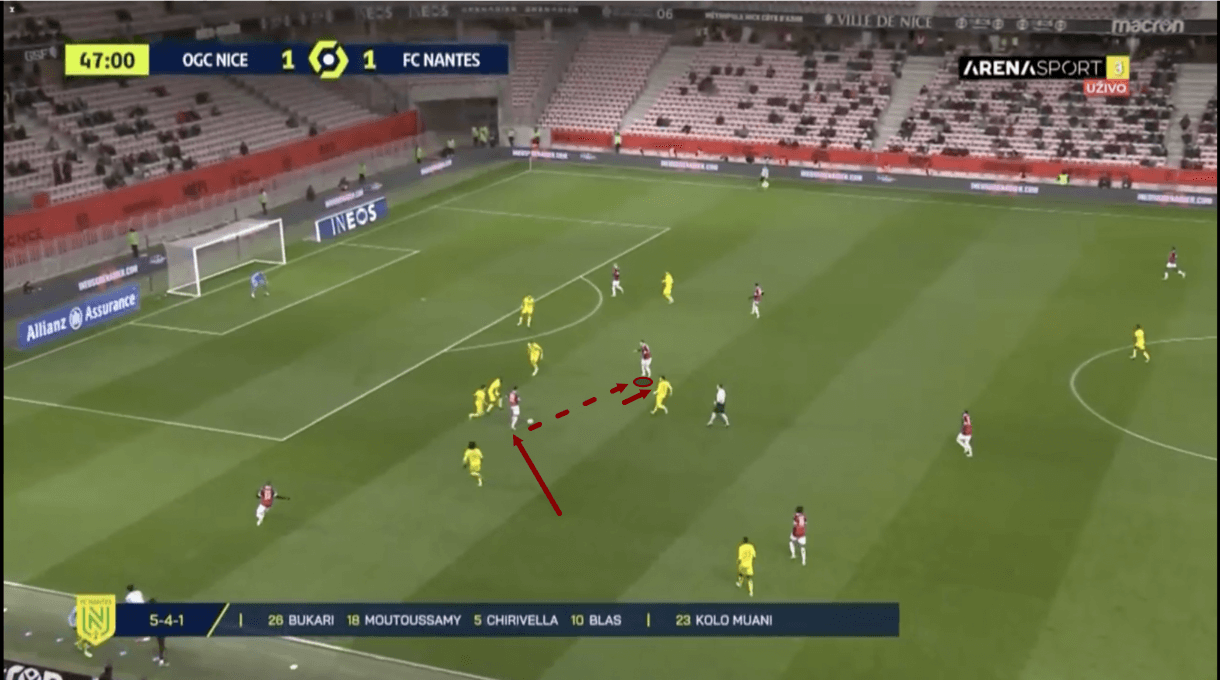
Moving on into figure 10, here we see Gouiri receiving in a more traditional number ‘10’ position, having drifted away from the opposition defenders and carved out a little pocket of space for himself centrally that he and his teammate on the ball can take advantage of by finding the 22-year-old in enough space to make something happen. Finding and occupying space in dangerous positions like this is another significant part of the Nice attacker’s game that has helped his output this season.
Here, the attacker’s teammate carried the ball into the left half-space, attracting opposition defenders towards him, which created the opening for Gouiri to intelligently drift away into space and make himself available for this ball carrier. As we can see the ball carrier was quick to take up the option that the 22-year-old presented to him via his dangerous movement and positioning in the ‘10’ position.
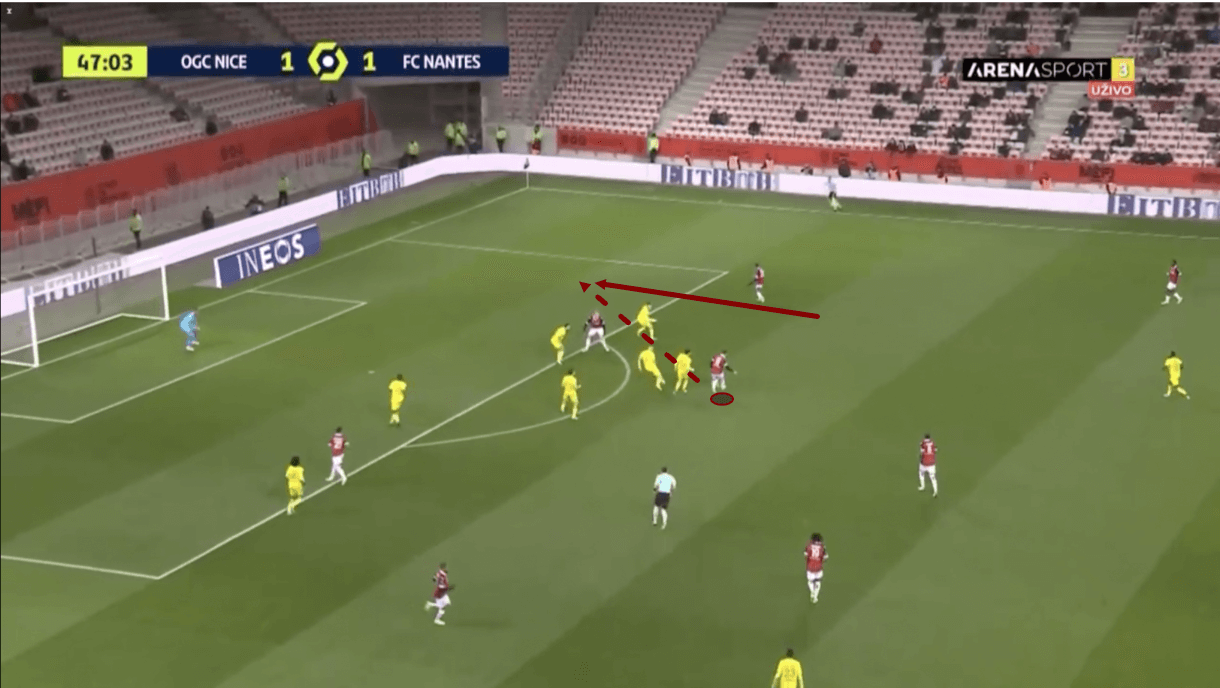
After receiving well and turning onto his stronger right foot again, Gouiri managed to thread a beautifully weighted through ball between opposition defenders to find the overlapping teammate as he attacked the opposition’s box in figure 11, highlighting his technical, on-the-ball creative ability and how he’s put it to good use for his team in impressive fashion in 2021/22. This is the kind of passing quality that’s been on show by Gouiri this term and a key reason as to why he’s thrived as Nice’s main source of creativity in the final third.
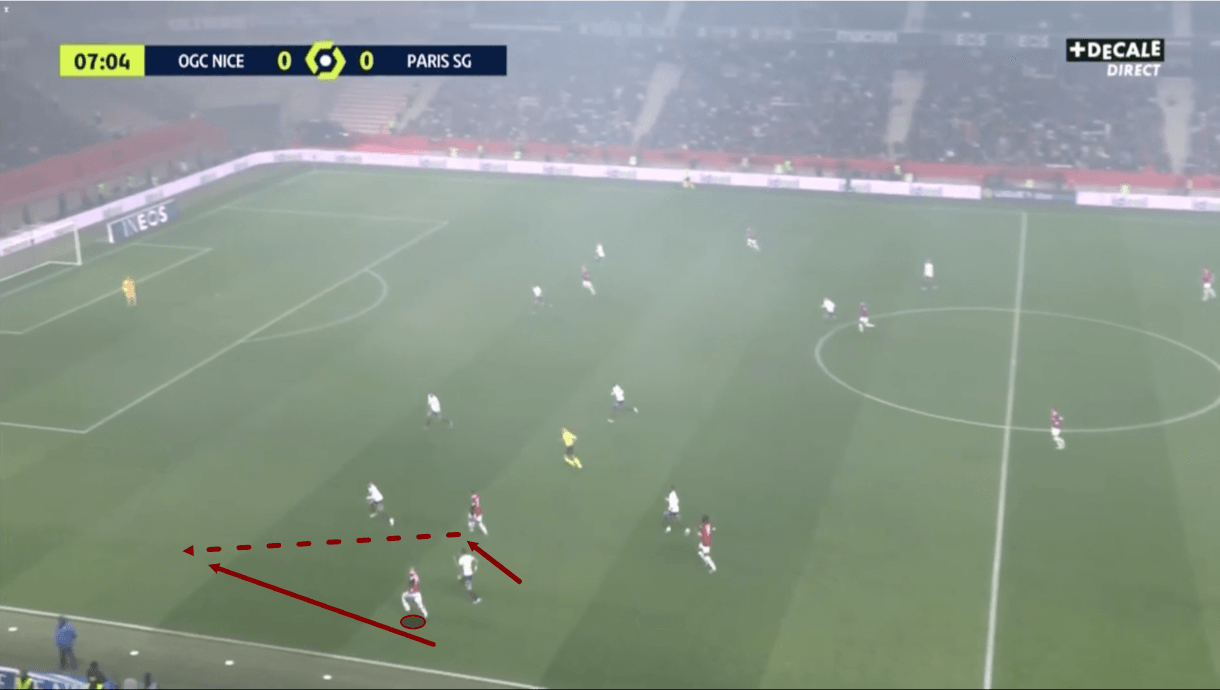
While Gouiri may be Nice’s main creative outlet at present, he’s not Les Aiglons’ only source of creativity. Another important source of creativity for Nice this term has been their high and wide aggressive full-backs, mainly Melvin Bard at left-back and Jordan Lotomba or Youcef Atal at right-back. Both of these men are required to get up and down the sideline all game in this demanding role within Galtier’s system.
Figure 9 showed one example of how Melvin Bard can be required to get forward quickly as Gouiri drops in order to give the creative passer a runner in behind to aim for with his pass and figure 12 shows another example of Bard’s important offensive role in this team, again linking with Gouiri as the attacker dribbles inside from the left-wing into the left half-space. Normally, you find Justin Kluivert playing on Nice’s left-wing and he plays a very similar role to the one we see Gouiri playing here in figure 12 in that he cuts inside from the left-wing, freeing up the space out wide for Bard to bomb forward and attack. Ideally, Galtier wants this to create a 2v1 overload for his team versus the opposition right-back, which is the case in figure 12.
As Gouiri dribbles into the half-space here, he attracts the opposition full-back away from the wing and into the more central position. Meanwhile, Bard then sprints down the wing outside the full-back, providing Gouiri with a passing option that the French attacker takes, sending Bard in behind and as play moves on from here, we see the left-back win a corner as a result of his cross.
Lotomba or Atal play a very similar role on the right and this role is important within this system for a couple of reasons. Firstly, Delort as a centre-forward provides a good aerial threat that Nice should at least be able to take advantage of — and the overlapping full-backs give them this option as the areas in which they typically receive the ball are excellent areas to cross from and provide Delort with aerial opportunities. It’s common to see Delort bend his runs towards the far post on the blind side of the defenders, with the crossers then required to float a high ball towards the back post to find the attacker. Delort’s movement is generally quite threatening and helpful for the crossers but Nice’s full-backs could improve their crossing accuracy still to provide him with the kind of opportunities that they have shown to be capable of more often.
The second reason the full-backs’ role is so important is that their responsibility in providing the width for their side in the final third can stretch the opposition’s defensive shape, thus creating space for the likes of Gouiri centrally, while it can also provide the likes of Gouiri with a good and dangerous passing option if the opposition ignore them and opt to remain central and compact. As a result, it’s clear how they often end up in important creative situations inside the final third.
Pressing
For the final section of analysis in this piece, I’m going to take a brief look at Nice’s tactics in the high-block phase, when pressing the opposition at the beginning of their attack. This will be brief as a full, detailed pressing analysis could be carried out to look into the technicalities of Galiter’s pressing tactics, marking systems and how they change depending on the situation. This section focuses more on a couple of specific points relating to one of Galtier’s clear, key aims in the high block phase — controlling the centre of the pitch.
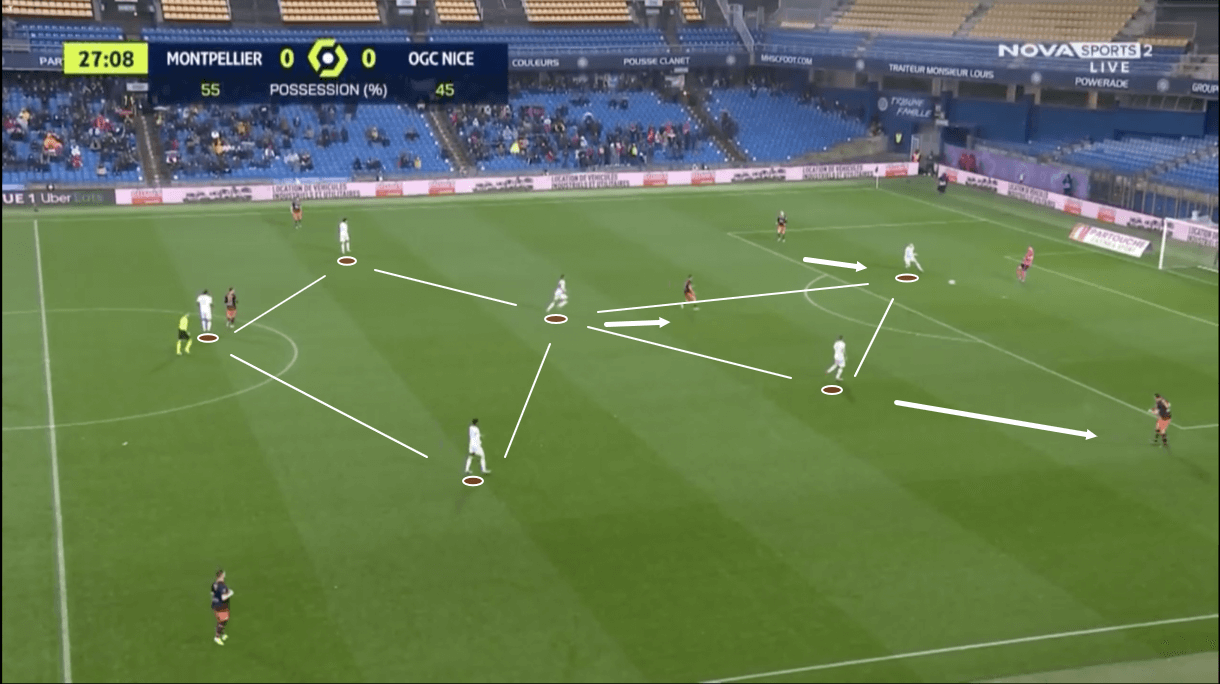
To kick this section of the analysis off, we can observe one interesting point about Nice’s defensive tactics in the high block phase beginning here in figure 13, which is that their 4-4-2 becomes more of a 4-diamond-2. This happens because 1. Their wingers tend to sit quite narrow and 2. Most importantly, one of their central midfielders, typically Lemina, tends to operate far more aggressively than the other and will perform a man-marking job on the opposition’s deepest midfielder. This rather aggressive role has seen Lemina make the most tackles (58) of any Nice player in France’s top-flight this term.
By playing aggressively like this, Lemina helps his team to equal the opposition’s number of players in the first line of build-up, making life far more difficult for them to get into the middle third of the pitch by denying them a numerical advantage. Meanwhile, the narrow wingers and holding midfielder (often Kluivert, Rosario and Hicham Boudaoui in these positions) ensure the centre is protected by essentially forming a three-man midfield, giving Nice a heavy numerical advantage in this area a lot of the time, as was the case in figure 13.
It’s worth noting that while Lemina performs a man-marking job, that doesn’t mean all of Nice’s players are man-marking. The rest of Nice’s players, as we see them here, are marking zonally, highlighting a mixed marking system designed to control the holding midfielder first and foremost, and then the rest of the centre of the pitch.
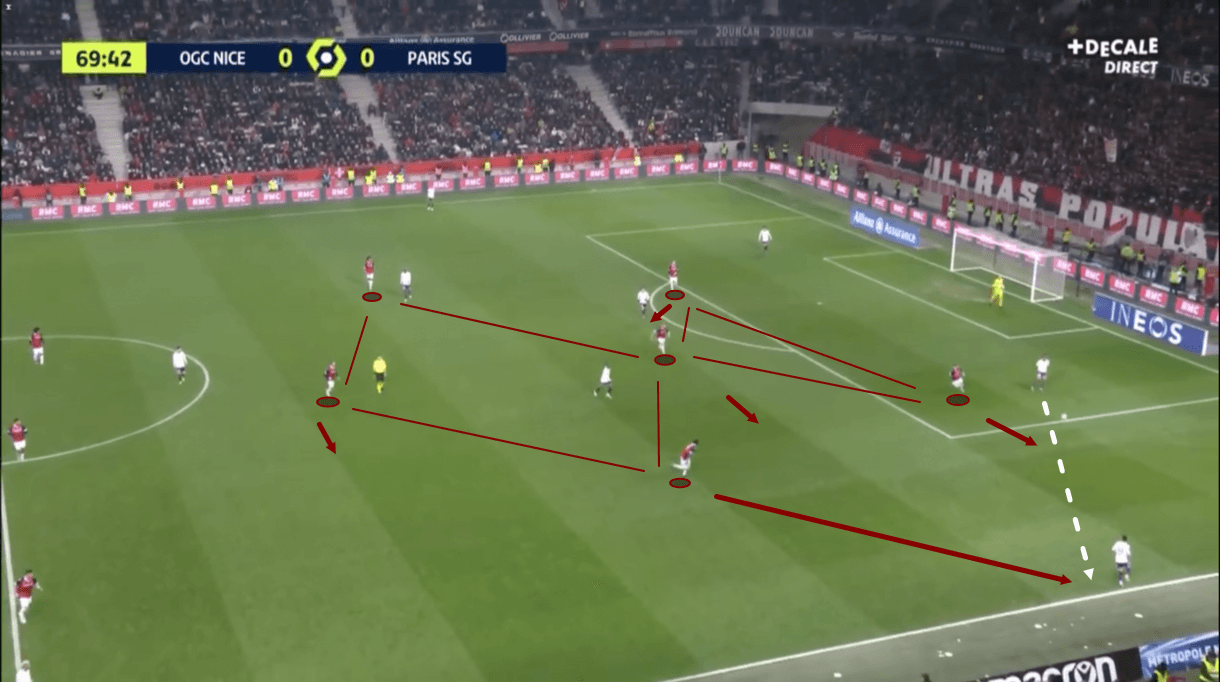
We see another example of this midfield diamond from another of Nice’s recent games in figure 14 and here, we see what happens as the ball moves out wide to the opposition’s full-back. Although the wingers take up a very narrow position, somewhat resemblant of a regular wide central midfielder in, for example, a 4-3-3, they are still wingers so as the ball moves out to PSG’s left-back in figure 14, Nice’s right-winger jumps into action and starts to close the receiver down while keeping the passing lane into midfield in his cover shadow.
Meanwhile, the ball-near full-back gets tight to the higher passing option on this wing and the rest of Nice’s diamond midfield shifts over to prevent too much space from opening where the right-winger has jumped out to press and to continue controlling the centre concerning where the opposition are now in possession of the ball. As they do shift over, Lemina will take over from the right-winger on the right side of the diamond, the ball-near striker will mark the ball-near centre-back and the ball-far striker will drop onto the holding midfielder, prioritising marking him over the ball-far centre-back, who is a difficult and more unattractive passing option in this situation.
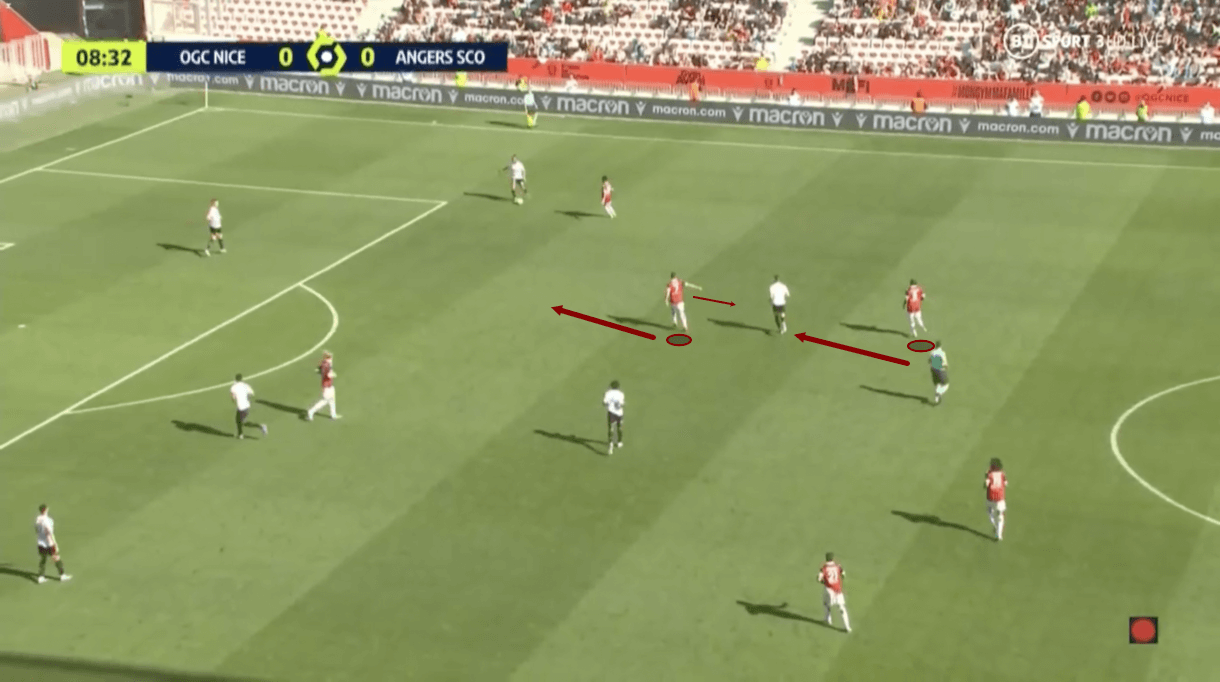
Lastly, figure 15 shows an example of Nice’s centre-forward passing the man-marking duties on one of the opposition’s holding midfielders in this example, to the central midfielder as the opposition have just moved the ball backwards and are now starting to outnumber Nice in their first line. This shows how regardless of who performs the marking job, someone is always sitting on the holding midfielder for Nice, it just depends on the situation and exact phase of play as to who is performing the duty at the time. In the high block, a central midfielder (usually Lemina) is responsible for this role but in deeper defensive phases, which was the case just before this image, a centre forward might drop onto the holding midfielder, allowing the central midfielder to protect space between the midfield and defensive lines. All in all, it’s clear that protecting the centre and controlling the holding midfielder, in particular, is a key part of Nice’s tactics in the high block.
Conclusion
To conclude this tactical analysis piece looking at Galtier’s Nice, I believe there are some really interesting player roles within the 55-year-old’s system at Les Aiglons, the most important of which, in my view, I’ve tried to outline from a tactical perspective in this piece within the context of their overall team strategy and tactics in the given passage of play in which I deem them to be most crucial. I hope that through this analysis, the thus far successful strategy and tactics, as well as personnel, of Galtier’s Nice are clearer.




Comments